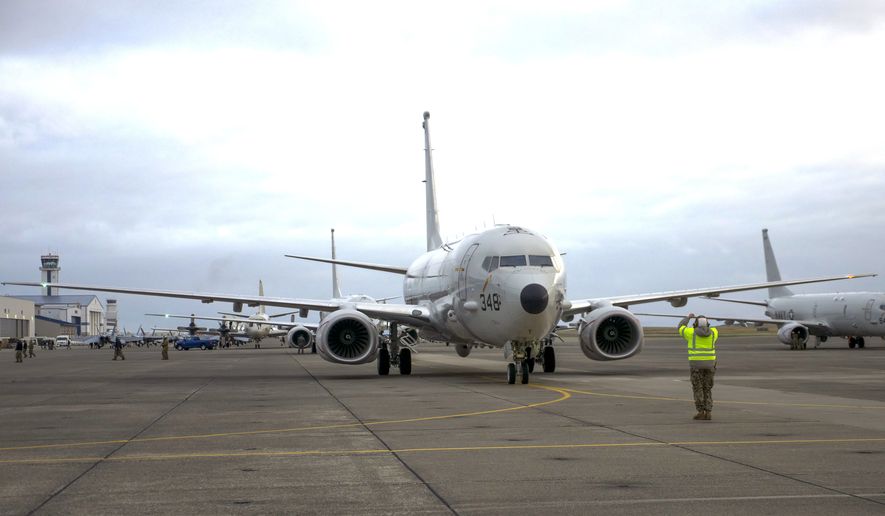Defense Secretary Mark Esper this week confronted China’s defense minister over the Chinese military’s use of a high-powered laser to illuminate a Navy patrol aircraft near Guam last month.
On Tuesday, Mr. Esper called Chinese Defense Minister Wei Fenghe to discuss several issues, including the Feb. 17 laser incident some 380 miles west of Guam.
“During the call, Secretary Esper raised concern over an incident on Feb. 17 in which a U.S. Navy P-8A Poseidon maritime patrol aircraft was lased by PRC navy destroyer 161 while flying in airspace above international waters,” the Pentagon said in a statement issued Friday.
The new statement revised guidance published earlier in the week that said the laser incident was not discussed between Mr. Esper and Gen. Wei.
China’s government made no mention of the laser incident in the official government readout of the Esper-Wei call, and the Chinese government’s spokesmen have been silent on the provocative action.
“Secretary Esper called on the People’s Liberation Army to conduct itself safely and professionally in accordance with bilateral agreements and international standards of safety at sea,” the statement said. “The incident underscores the need for the two militaries to enhance bilateral crisis communication mechanisms to ensure incidents like this do not escalate or lead to miscalculation.”
The P-8A is armed with torpedoes and Harpoon anti-ship missiles.
Firing a laser can be considered a hostile action in some circumstances — for example, if the laser were part of an anti-aircraft defense system.
U.S. military forces operate under rules of engagement that allow ships and aircraft to defend themselves during such encounters.
China has deployed several types of laser weapons, including laser dazzlers designed to disrupt optics or electronics, and laser guns designed to damage the eyes of enemy forces.
The Pacific Fleet said in a statement issued 10 days after the encounter that a Chinese guided-missile destroyer fired a high-powered laser against the P-8A, a maritime patrol aircraft.
It was the second time the Chinese military engaged in the provocative practice of aiming lasers at U.S. aircraft.
An earlier incident involving ground-based laser firings from a Chinese military base in Djibouti, on the Horn of Africa, injured the eyes of C-130 aircrews.
No pilots or crew were injured in the P-8A laser illumination that was detected by onboard sensors.
The last major U.S.-China military standoff took place in the South China Sea in September 2018, when a Chinese warship nearly collided with the USS Decatur, a Navy guided-missile destroyer.
The Pentagon response to the laser incident contrasts sharply with that of the State Department, which sought to downplay the incident.
The U.S. Embassy in Beijing lodged a formal diplomatic protest with the Chinese government on Feb. 18, but State Department spokeswoman Morgan Ortagus declined to comment on the formal protest or the provocative Chinese action.
“We have nothing for you,” she told The Washington Times.
The Pacific Fleet statement noted that the action by the People’s Liberation Army (PLA) Navy vessel violated at least two agreements with the Chinese military designed to prevent such encounters from leading to a military confrontation or conflict.
“The PRC navy destroyer’s actions were unsafe and unprofessional,” the Pacific Fleet said. “Additionally, these acts violate the Code for Unplanned Encounters at Sea (CUES), a multilateral agreement reached at the 2014 Western Pacific Naval Symposium to reduce the chance of an incident at sea. CUES specifically addresses the use of lasers that could cause harm to personnel or damage to equipment.”
The lasering also was inconsistent with a U.S.-China memorandum of understanding regarding the rules designed for safe air and maritime encounters.
“The laser, which was not visible to the naked eye, was captured by a sensor onboard the P-8A,” the statement said. “Weapons-grade lasers could potentially cause serious harm to aircrew and mariners, as well as ship and aircraft systems.”
The patrol aircraft was part of a Navy unit from Jacksonville, Florida, based at Kadena Air Force Base in Okinawa, Japan.
The aircraft was conducting routine maritime and reconnaissance flights in the Philippine Sea.
“U.S. Navy aircraft and ships will continue to fly, sail, and operate wherever international law allows,” the statement said.
Critics have faulted the Navy and Pentagon for not pushing back vigorously against the laser illuminations, warning that unless the U.S. aggressively confronts China over the incidents, they will continue.
Chinese state-run media said Gen. Wei told Mr. Esper that U.S. and Chinese military forces should “adhere to the general tone of coordination, cooperation, and stability, resolve differences through dialogue and consultation in the spirit of equality and mutual respect, and promote the development of China-U.S. relations along the right track.”
The Chinese report also said Mr. Esper expressed a willingness to enhance dialogue and consultation between the two militaries and bolster exchanges and cooperation.
• Bill Gertz can be reached at bgertz@washingtontimes.com.




Please read our comment policy before commenting.